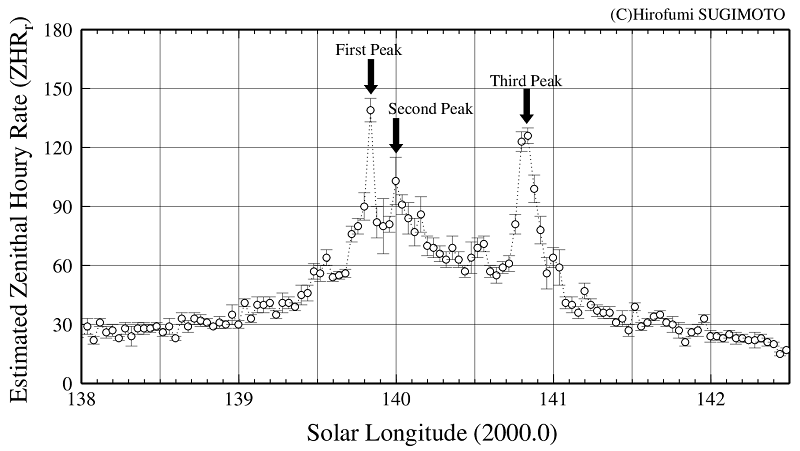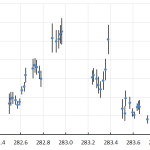Hirofumi Sugimoto and Hiroshi Ogawa
Abstract: Radio meteor observations in the world detected two unexpected peaks in the Perseid activity profile of 2023 before and after the annual peak around λʘ = 140.00°. One peak occurred at λʘ = 139.84° (August 13, 3h30m UT) with an estimated ZHRr = 139 (Activity Level Index (AL) = 1.9). Although this peak corresponds with a prediction for the encounter of a weak filament, it was so weak that it was not sure. Another peak was observed at λʘ = 140.84° (August 14, 04h30m UT) with ZHRr = 126 (AL = 1.6). It is possible that this peak was caused by an old dust trail which was released in 68BC, but it appeared later than expected in the prediction or it related to the secondary peak which was detected in previous years between λʘ = 140.5° and 141.6°.
1 Introduction
The Perseids are one of the best meteor showers in a year. The shower reaches a maximum with a ZHR = 100 at λʘ = 140.0° for visual observers (Rendtel 2022).
Radio Meteor Observation is also able to obtain a complete activity profile. In past research, activity profiles were derived from worldwide radio data from Radio Meteor Observation Bulletin (RMOB). As a result, The International Project for Radio Meteor Observations (IPRMO) which is organized to analyze a complete meteor shower activity without problems with radiant elevation and unstable weather, concluded that the peak of the Perseids occurred at λʘ = 140.0° with FWHM (Full Width of Half Maximum) = –0.7°/+0.8° and a peak Activity Level of 1.2 (Ogawa, 2022).
Another peak was detected between λʘ = 140.5° and λʘ = 141.6° in recent years (Miskotte & Vandeputte, 2020; Miskotte, 2020; Miskotte et al., 2021). Besides, a surprisingly strong peak was observed at λʘ = 141.5° in 2021 (Miskotte et al., 2021). The cause of this post maximum peak has not been clarified yet.
For 2023, the Meteor Shower Calendar published by the International Meteor Organization (IMO) described a possible encounter with a very old trail released in 68 BC at λʘ = 140.74° and a weak filament at λʘ = 139.83° (Rendtel, 2022). A secondary peak was observed around λʘ = 141° using Global Meteor Network (GMN) data (Roggemans, 2023). This paper reports the result for the Perseids 2023 using worldwide radio meteor observations.
2 Method
For analyzing the worldwide radio meteor observation data, the meteor activity is calculated by the “Activity Level Index: AL(t)” (Ogawa et al., 2001) and the estimated Zenithal Hourly Rate: ZHRr(t) (Sugimoto, 2017). The activity profile was estimated using the Lorentz activity profile (Jenniskens et al., 2000).
3 Results
Figure 1 shows the result of an estimated ZHRr in 2023. Three significant peaks were observed in this year. The first peak occurred at λʘ = 139.84° (August 13, 3h30m UT). The estimated peak reached ZHRr = 139 (AL = 1.9). A secondary peak was observed at λʘ = 140.00° (August 13, 07h30m UT) with ZHRr = 103 (AL = 1.4). Finally, a third peak which had ZHRr = 126 (AL = 1.6) at λʘ = 140.84° (August 14, 04h30m UT) was detected. Table 1 shows the three detected peaks in estimated ZHRr and Activity Level Index.
Table 1 – The estimated ZHRr and Activity Level Index (AL).
| Peak Time (UT) | λʘ (˚) | ZHRr | Activity Level (AL) |
| Aug 13 03h30m | 139.84 | 139±6 | 1.9±0.4 |
| Aug 13 07h30m | 140.00 | 103±12 | 1.4±0.4 |
| Aug 14 04h30m | 140.84 | 126±4 | 1.6±0.3 |
4 Discussion
4.1 Comparing with the average of the past
Figure 2 compares the results between the Activity Level in 2023 and the average in the past during the period 2001–2022. The first and third peaks are not visible in the average of the past, but the second peak was very similar to the maximum in the past. Therefore, the first and third peaks represent unusual activity in 2023.

Figure 2 – The Activity Level Index: Comparing the average from the past (gray line) to the Activity Level Index in 2023. (circles with error: 2023).
4.2 How to explain the three peaks?
Figure 3 shows that the Activity Level Index of the Perseids 2023 displayed three components by using the Lorentz profile. Table 2 shows the estimated components and some references.

Figure 3 – The Activity Level Index: the estimated components using the Lorentz Profile (solid line: Comp1+Comp2+Comp3).
Table 2 – The estimated components using the Lorentz profile and some references.
|
Radio Results by IPRMO |
References |
||||||
|
|
Peak Time (UT) | λʘ | FWHM (hours) | Peak Level | Peak Time (UT) | λʘ | Source |
| Comp.1 | Aug 13 03h30m | 139.84° | -1.0/+1.0 | AL=0.5 (ZHRr=55) | Aug 13 03h | 139.83° | P.Jenniskens |
| Aug 13 7h30m | 140.0° | annual | |||||
| Comp.2 | Aug 13 08h30m | 140.04° | -16.0/+13.5 | AL=1.4 (ZHRr=90) | |||
| Aug 14 1h – 2h45m | 140.74° | J. Vaubaillon | |||||
| Comp.3 | Aug 14 04h30m | 140.84° | -3.5/+1.5 | AL=1.2 (ZHRr=85) |
|
||
4.2.1 Component 1
The first peak represents a component (Comp.1) which had AL(max) = 0.5 at λʘ = 139.84° (August 13, 3h30m UT). Jenniskens (2006) described that a weak filament encountered the Earth at λʘ = 139.83°±0.2°. Although the first peak seems to fit with the forecast, it was difficult to conclude that this was the encounter with the small filament because this peak had a very small activity level and a narrow FHWM.
4.2.2 Component 2
It is possible that the second peak (Comp.2) represents the main peak from the past activity. Using the Lorentz profile this component was estimated with AL(max) = 1.4 at λʘ = 140.04° (August 13, 8h30m UT).
4.2.3 Component 3
The third peak had its maximum with AL(max) = 1.2 at λʘ = 140.84° (August 14, 4h30m UT) (Comp.3). According to Vaubaillon as mentioned in the Meteor Shower Calendar published by IMO that a very old dust trail released in 68 BC may be encountered around λʘ = 140.74° (between 01h and 02h45m UT on August 14). Although the observed enhancement in activity was later than this prediction, it is possible that this activity was caused by this old trail.
However, on the other hand, it is also possible that this third peak is related to the secondary peak around λʘ = 140.5°–141.6° which was observed in previous years.
It is very difficult to know whether or not an old dust trail and an unexpected peak activity are somehow related to the secondary peak observed in past years.
5 Conclusion
Radio meteor observations in the world observed three peaks during the Perseids 2023 and these could be identified as three different components. Comp.1 was the first peak with a modest and short activity at λʘ = 139.84°. Comp.2 represents the annual activity peak at λʘ = 140.04°. Comp.3 was the third peak at λʘ = 140.84°.
Although worldwide radio meteor observations succeeded to detect three peaks, it remains very difficult to explain the cause of these enhancements, except for Comp.2.
Acknowledgment
The worldwide data were provided by the Radio Meteor Observation Bulletin (RMOB). The following observers provided data:
Chris Steyaert (Belgium), Felix Verbelen (Belgium), johan coussens (Belgium), FLZ-R0 (Czech republic), SVAKOV-R12 (Czech Republic), VALMEZ-R1 (Czech Republic), ZEBRAK-R5 (Czech Republic), FREDERIC LUCAS (France), Jacques Molne (France), Philippe RAINARD (France), DanielD SAT01_DD (France), Pierre Terrier (France), Istvan Tepliczky (Hungary), GABB.IT (Italy), Romano Serra (Italy), AAV Planetario di Venezia (Italy), Filzi School Observatory D12 (Italy), Mario Bombardini (Italy), Hirofumi Sugimoto (Japan), Hironobu Shida (Japan), Hiroshi Ogawa (Japan), Kenji Fujito (Japan), Masaki Kano (Japan), Masaki Tsuboi (Japan), Minoru Harada (Japan), Nobuo Katsura (Japan), Norihiro Nakamura (Japan), Rainer Ehlert (Mexico), Salvador Aguirre (Mexico), MAR JEN (Poland), Rafael Martinez (Puerto Rico), Esteban Reina (Spain), Ian Ian_Evans (United Kingdom), Philip Norton (United Kingdom), Philip NortonVert (United Kingdom), Philip Rourke (United Kingdom), Tracey Harty (United Kingdom), Eric Smestad_KC0RDD (United States of America), Stan Nelson (United States of America)
We wish to thank Pierre Terrier for developing and hosting rmob.org. A very special thank you to Paul Roggemans for proofreading this article.
References
Jenniskens P., Crawford C., Butow S. J., Nugent D., Koop M., Holman D., Houston J., Jobse K., Kronk G., and Beatty K. (2000). “Lorentz shaped comet dust trail cross section from new hybrid visual and video meteor counting technique imprications for future Leonid storm encounters”. Earth, Moon and Planets, 82–83, 191–208.
Miskotte K. and Vandeputte M. (2020). “Perseids 2019: another peak in activity around solar longitude 141.0?”. eMetN, 5, 25–29.
Miskotte K. (2020). “Perseids 2020: again, enhanced Perseid activity around solar longitude 141?”. eMetN, 5, 395–397.
Miskotte K., Sugimoto H. and Martin P. (2021). “The big surprise: a late Perseid outburst on August 14, 2021!”. eMetN, 6, 517-525.
Ogawa H., Toyomasu S., Ohnishi K., and Maegawa K. (2001). “The Global Monitor of Meteor Streams by Radio Meteor Observation all over the world”. In, Warmbein Barbara, editor, Proceeding of the Meteoroids 2001 Conference, 6-10 August 2001, Swedish Institute of Space Physics, Kiruna, Sweden. ESA Publications Division, European Space Agency, Noordwijk, The Netherlands, 189–191.
Ogawa H. (2022). “Long-Term Studies of Major and Daytime Meteor Showers using Worldwide Radio Meteor Observations”. WGN, Journal of the IMO, 50, 148-157.
Rendtel J. (2022). “2023 Meteor Shower Calendar”. International Meteor Organization
Roggemans P. (2023). “Second Perseid Peal at S.L. 141° Confirmed in 2023”. eMetN this issue.
Sugimoto H. (2017). “The New Method of Estimating ZHR using Radio Meteor Observations”. eMetN, 2, 109–110.





Good job